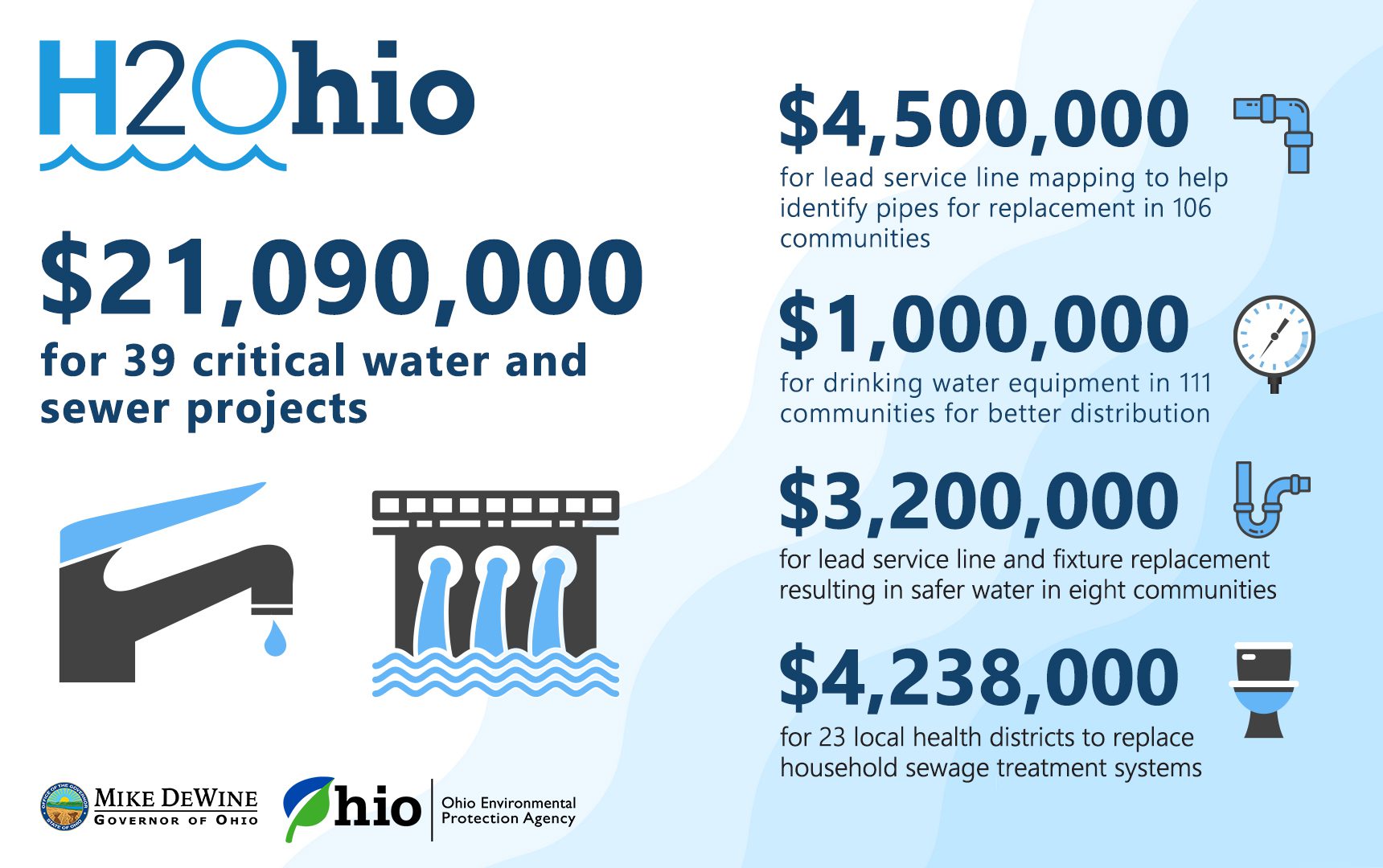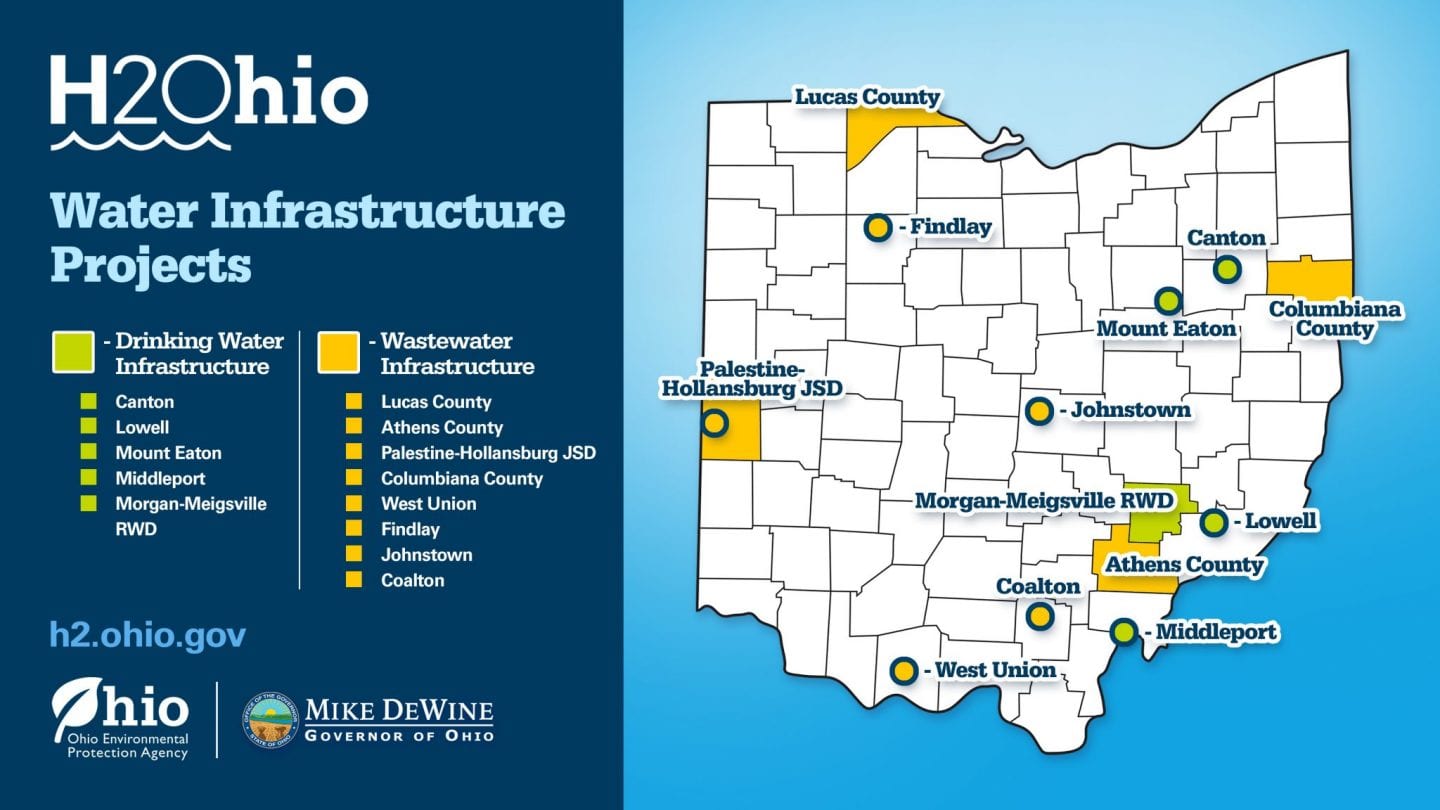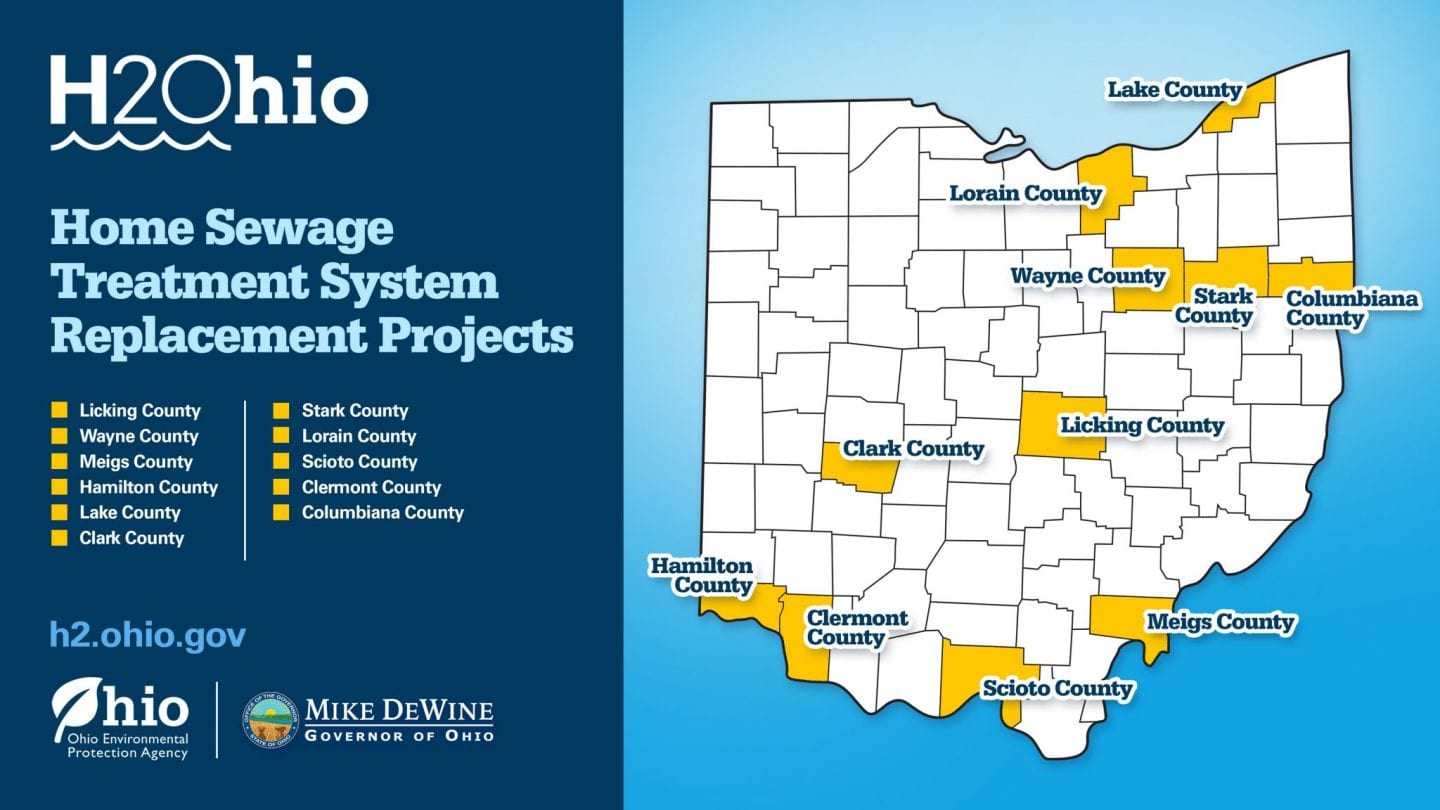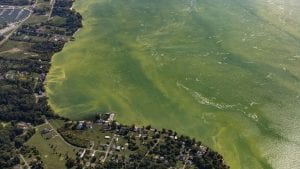Ohio Environmental Protection Agency
ENHANCING WATER QUALITY AND IMPROVING PUBLIC HEALTH
Ohio’s communities rely on clean drinking water and wastewater infrastructure to protect public health; however, some people still don’t have access to good, quality drinking water or sewer systems. H2Ohio will help ensure clean water by:
Funding water infrastructure projects in disadvantaged communities to provide safe drinking water and sewer services;
Fixing or replacing hundreds of failing home sewage treatment systems in low-income areas;
Replacing lead pipes and fixtures at high-risk daycares and schools;
Funding restoration projects geared toward better water quality;
Increasing water quality monitoring across the state.
Funding Water Infrastructure Projects
Ohio EPA will fund infrastructure projects in disadvantaged communities to increase access to safe drinking water and sewer services. Projects include the construction of a new water treatment plant, the replacement of aging water lines, and the installation of new water lines and water mains. New wastewater infrastructure projects will solve sewer system backups, extend sanitary sewers, and replace failing household sewage treatment systems with new sewers. Projects are selected based on the community’s economic needs and project readiness.
Addressing Failing Home Sewage Treatment Systems
It is estimated that approximately 31 percent of all household sewage treatment systems in Ohio are experiencing some degree of failure and are discharging untreated sewage that potentially exposes citizens to harmful bacteria and pathogens. H2Ohio funding will go to counties to help low- to moderate-income households repair and replace failing home sewage treatment systems.
Replacing Lead Service Lines
Lead service lines can be a major source for lead contamination in water. Ohio EPA funding goes to replacing these pipes in communities and daycares centers. Funding also goes towards lead service line mapping, which is the first step towards identifying these toxic pipes.
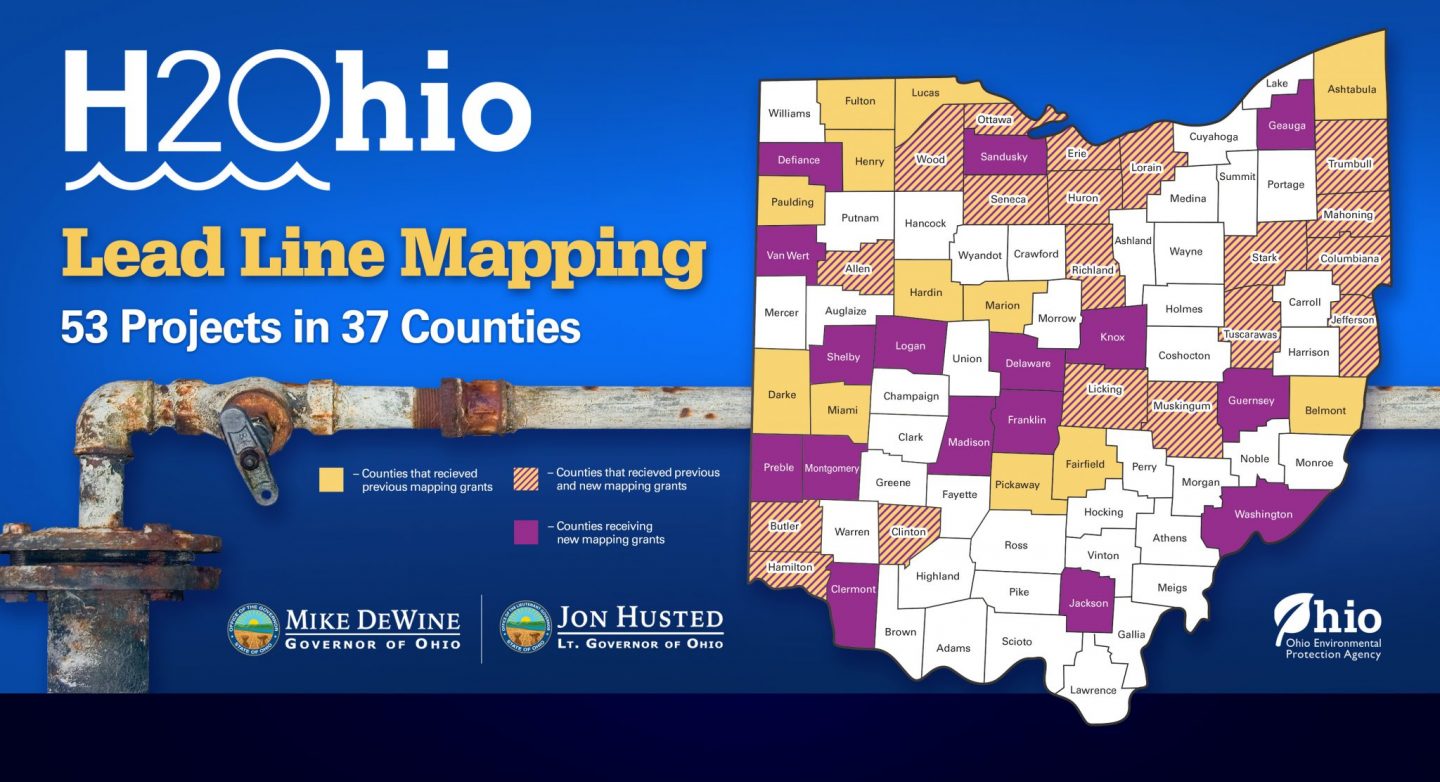
Water Quality Restoration Projects
Ohio EPA will fund restoration and remediation projects in Ohio geared toward better water quality like the Gorge Dam Removal and Mentor Marsh Restoration.
Adding Water Quality Monitors
Ohio EPA has a statutory obligation (6111.03) that requires the Agency to conduct a study of nutrient mass balance for both point and nonpoint sources every two years. To begin fulfilling this requirement the agency published the Nutrient Mass Balance Study for Ohio’s Major Rivers report in 2016 and 2018. The combined areas of the watersheds included in the 2018 report were nearly 23,000 square miles or 66% of Ohio’s watersheds.
H2Ohio will expand nutrient monitoring of three additional watersheds: the Little Miami, the East Fork Little Miami, and Hocking rivers. Streamflow has been measured at these pour points for watersheds for several decades, so H2Ohio dollars will provide USGS $186,000 to purchase and install new nutrient monitoring equipment and $297,000 for monitoring and maintenance through the current state budget.
With the addition of these watersheds, nearly 3,000 square miles will be added to the nutrient mass balance covered area. This will increase the coverage of the mass balance study to greater than 72.59% of Ohio’s watersheds.
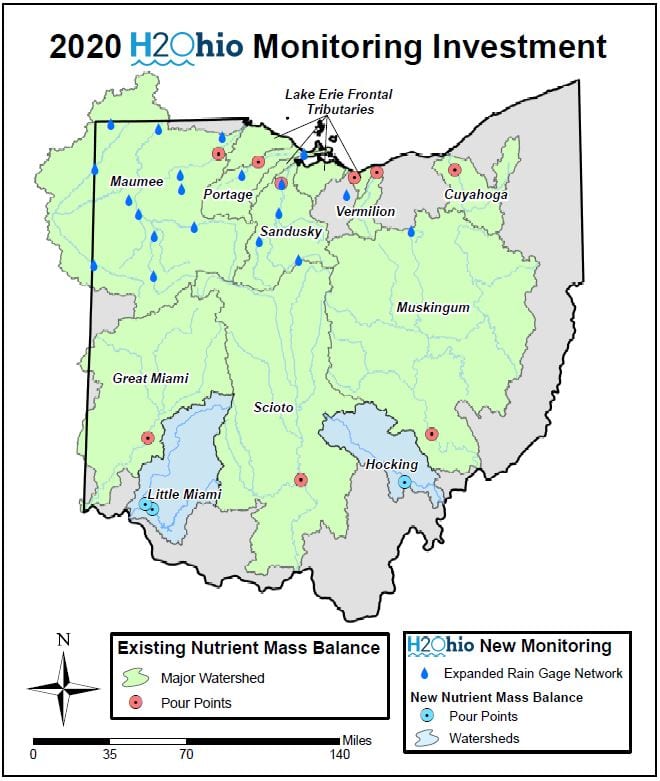
H2Ohio Technology Assessment Program
In support of efforts to address Harmful Algal Blooms, State agencies are often presented with emerging technologies for reducing nutrient loading and reducing HABs. Since these technologies are typically innovative, proprietary, and span multiple scientific disciplines, state agencies alone are not best positioned to evaluate the efficacy and feasibility of these technologies.
To help the State evaluate these technology proposals, the Ohio Environmental Protection Agency developed the H2Ohio Technology Assessment Program (TAP). The goal of this new program is to identify promising new technologies, validate those technologies, and facilitate demonstration projects to determine their effectiveness at scale.
H2Ohio TAP is specifically interested in technologies that:
- reduce nutrient loading to rivers, streams, and lakes;
- remove nutrients from rivers, streams, and lakes;
- reduce the intensity or toxicity of algal blooms;
- recover nutrients from manure; and
- improve nutrient removal in wastewater treatment plants.
Ohio EPA developed and issued a Request for Technologies in 2020 to solicit technologies for assessment. Over 40 proposals were received. To assist with this effort, the Ohio Lake Erie Commission established a public advisory group called the H2Ohio TAP Team to help narrow down technologies for further assessment. The H2Ohio TAP Team identified the 10 most promising technology proposals and Ohio EPA selected Tetra Tech as a third-party vendor, to perform an in-depth assessment of these 10 technology proposals.
These 10 technologies are summarized below. Each of the technologies are listed with:
- A general overview of the technology.
- A link to the Tetra Tech assessment.
- A summary of status of any demonstration projects associated with the technology conducted by the H2Ohio TAP program with any applicable links.
QuickWash Phosphorus Recovery
Overview:
QuickWash® is a suite of United States Department of Agriculture (USDA) patented technologies focused on the recovery of excessive phosphorus (QW-P). The QW-P technology has significantly reduced phosphorus in multiple Ohio applications including municipal wastewater, agricultural manure (swine, dairy and egg operations), and lagoon based treatment systems. The QW-P process results in three co-product streams: 1) amorphous calcium phosphate; 2) dewatered manure; and 3) a treated water stream that contains significantly lower phosphorus which has been demonstrated to be an effective source of irrigation water on crop land. TetraTech concluded that research and pilot projects clearly demonstrate the effectiveness of the technology. TetraTech recommended additional research on the value and markets for the co-products generated by implementation of QuickWash®. This technology has been selected for further study in a U.S. EPA Great Lakes Restoration Initiative (GLRI) funded study described following the summary of the ten TAP technologies below.
Demonstration project status:
A two-part demonstration project funded by a Great Lakes Restoration Initiative (GLRI) grant of $900,000 to Ohio EPA with a 100% passthrough subgrant to Maumee Watershed Alliance is currently in progress. The project includes both QuickWash® and another TAP technology, Regen (described below). The QuickWash® phase of the project involves processing swine manure at two WLEB locations. The process results in four co-product streams: 1) high-P solids; 2) dewatered low-P manure; 3) ammonium salt; and 4) a treated water stream that contains significantly lower P as a source of irrigation water on crop land. The high-P solids and dewatered low-P manure from the QuickWash® processing is being used in the second phase of the project using Regen technology.
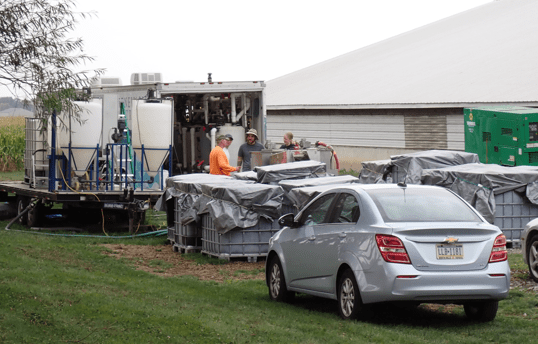
QuickWash® demonstration project setup at WLEB hog farm in October 2023.
Nutrient Regeneration (Regen)
Overview:
Regen is a process for removing nutrients from biomass sources, such as manure lagoons and converting them into stable commodity products. This process takes a systems approach for managing waste streams and utilizing their materials handling and distribution systems to better utilize nutrients and by-products. Tetra Tech determined, a demonstration project targeting Regen within one or more Lake Erie subbasins could evaluate the ability of financial incentives to spur landowners to use this technology and could also provide more detailed data about nutrient load reductions, crop yield increases, and potential constraints to using Regen within the Lake Erie drainage basin.
Demonstration project status:
A two-part demonstration project funded by a Great Lakes Restoration Initiative (GLRI) grant of $900,000 to Ohio EPA with a 100% passthrough subgrant to Maumee Watershed Alliance is currently in progress. The project includes both Regen and another TAP technology, QuickWash® (described above). The Regen process use processed manure from Phase 1 (QuickWash®) and other ingredients to produce soil health products:
-
- Soilbuilder Regen Organics
- Nutri-Pellets
- Regen Char
- Nutra-Sorb Filter Sock Media
Dispersible Granule Struvite Fertilizer
Overview:
Struvite Dispersible Granule (Struvite DG) Fertilizer technology produces commercial fertilizer from multiple waste streams including wastewater, sewage, or livestock wastes. Struvite DG has been utilized in turf and specialty markets but is currently not used in agricultural markets because of supply chain and economic restraints. Tetra Tech demonstration project targeting widespread adoption of Struvite DG® within the Lake Erie watershed could evaluate the ability of financial incentives to spur farmers/landowners to use this technology and provide more detailed data about nutrient load and best management practices reduction, crop yield, and potential constraints to using the technology within the Lake Erie watershed.
Demonstration project status:
A project demonstrating the use of Struvite as a replacement for Phosphorus (P) fertilizer is currently underway. The project is administered by Ohio EPA with a passthrough subgrant to The Ohio State University and is currently in progress in early stages. The project will be demonstrated in a field study and a plot study covering two crop rotations of corn and soybeans over 4 years. These studies will compare the use of struvite with commercial fertilizer at the following application rates:
- Zero P (control)
- Full tri-state recommended rate of struvite
- Half tri-state recommended rate of struvite
- Full tri-state recommended rate of monoammonium phosphate fertilizer (MAP)
- Half tri-state recommended rate of MAP

Struvite (SmartPHOS DG) being loaded for application in Field Study in October 2023

Application of field treatments, October 2023
Automated Drainage Water Management
Overview:
Automated drainage water management (ADWM) is a system of remotely controlling water levels in soil to improve both the environmental and agricultural performance in tile-drained farms. Tetra Tech determined that ADWM is very likely to be effective at reducing nutrient loading to Lake Erie, in direct proportion to the number of agricultural fields to which it is applied. Tetra Tech recommends a demonstration project of ADWM could evaluate the ability of financial incentives to spur landowners to use this technology and could also provide more detailed data about nutrient load reductions, crop yield increases, and potential constraints to using ADWM within the Lake Erie drainage basin.
Demonstration project status:
A demonstration project funded by a Great Lakes Restoration Initiative (GLRI) grant of $500,000 to Ohio EPA with a 100% passthrough subgrant to The Ohio State University (OSU) is currently in progress. The project scope includes the installation of 10 ADWM control structures at farms in the Lost River watershed in the WLEB. Five of the systems will be controlled remotely by OSU and five controlled locally by the producer over 3 years. Two fields will be selected for water quality monitoring by OSU, digital materials will be development to inform and educate producers on ADWM and a producer-friendly decision support tool will be developed.
Electric Cell Lysis
Overview:
The Electric Cell Lysis technology utilizes, precisely controlled, electrical pulses to break down liquid, organic, wastes in manure lagoons. Prior pilot studies have been completed and Electric Cell Lysis technology would enable producers to actively manage their waste on-site, reduce pathogens, and reduce odor associated the land application of manure. Tetra Tech’s evaluation has determined that Electric Cell Lysis is likely to be effective at reducing nutrient loading to Lake Erie, in direct proportion to the number of livestock operations to which it is applied through demonstration projects.
Demonstration project status:
Ohio EPA is working with Cleveland Water Alliance for development of a project demonstrating electric cell lysis.
Hypernucleation Flotation Technology
Overview:
Hypernucleation Floation Technology (HFT) is a treatment process for water bodies with high total suspended solids in which a chemical is added to the lake; blue-green algae (HAB) floc to the lake surface; and the debris containing the algae is skimmed off of the lake. As the only TAP technology to physically remove HABs from the water body, HFT has been proven to be highly effective in other states.
Demonstration project status:
The Ohio Department of Natural Resources (ODNR), under its H2Ohio program and with grant support from the Ohio Water Development Authority (OWDA), demonstrated the technology at William H. Harsha (Harsha) Lake in a project completed in September 2022. Harsha Lake, is a 2,160-acre reservoir located in Clermont County within the East Fork Little Miami River watershed. The goals of the demonstration were to:
-
- evaluate the effectiveness and safety of the HFT algae harvesting system to remove algae, key nutrients, and toxins;
- educate and engage the community and stakeholders;
- evaluate the potential beneficial use of the recovered algae to produce clean energy, rather than commit it to costly landfills; and
- determine how best to use the technology as a cost effective and sustainable tool to address HABs in Ohio.
The Harsha Lake demonstration showed that algae and key nutrients can be harvested from the waterbody, dewatered, and transformed into a biofuel. The results support the use of this innovative technology at scale as a safe, effective and sustainable tool to address nutrient enrichment and HABs in Ohio waterbodies.
Intermittent Baffled BioReactor
Overview:
Intermittent Baffled BioReactor (iBBR) is a modification and improvement to a proven and mature wastewater treatment technology (the baffled bioreactor or BBR). The iBBR process applies aeration intermittently, which enhances total nutrient and phosphorous removal from the wastewater treatment plant effluent. Tetra Tech agreed that the technology, iBBR, is effective at reducing point-source discharge of TN and TP from WWTPs. TetraTech suggested that additional research is needed on how iBBR performs at controlling point-source nutrient discharges, in systems operating at higher capacity than those tested in the past. This could be a goal of a pilot project funded by H2Ohio.
Demonstration project status:
A demonstration project for this technology has not yet been conducted in the H2Ohio TAP program.
Novel Non-P Treatment Chemicals Derived from Sugar, Solugen Inc. AcquaCore™ (previously identified as BioChelate™ Pro)
Overview:
The Solugen AcquaCore™ technology is a proprietary enzyme-based chemical that is produced by converting domestically grown United States corn sugar with no dependence on overseas suppliers. The technology is a replacement for traditional chemical phosphorus-based corrosion and scale inhibitor products commonly used by industrial water treatment end users. TetraTech agreed that the AcquaCore™ technology is effective at controlling scale and corrosion and can reduce phosphorus content in dosage formulations as demonstrated in the studies provided. Additional research is needed on how AcquaCore™ performs at reducing nutrient loads (instead of relying on lab studies) at large scale within the watershed. This could be a goal of a pilot project funded by H2Ohio along with Solugen’s emerging product identified as AcquaCoreX™ (phosphorus-free technology). A more comprehensive analysis is recommended to evaluate sustainable long-term cost factors.
Demonstration project status:
A demonstration project for this technology has not yet been conducted in the H2Ohio TAP program.
ClariPhos
Overview:
ClariPhosTM is an inorganic liquid coagulant developed from rare earth elements lanthanum and cerium. ClariPhosTM has the capability of lowering total phosphorus concentrations in wastewater to ultralow levels of less than 0.07 milligrams per liter (mg/L). This innovative coagulant can be used to remove phosphorus from several wastewater treatment streams including existing municipal wastewater treatment plants, lagoons, or ponds. TetraTech agreed that the technology is effective at reducing point-source discharge of total phosphorus from wastewater treatment plants and its performance is well-documented. ClariPhosTM is a cost effective technology when compared to other technologies available to small community systems to treat point-source nutrient discharges. The cost per pound of phosphorus removed and cost per 1,000 gallons of wastewater treated are lower than or comparable to other available technologies, with the added potential cost savings of reduced O&M and sludge management.
Demonstration project status:
A demonstration project for this technology has not yet been conducted in the H2Ohio TAP program.
Phoslock Phosphorus Locking Technology
Overview:
Phoslock Phosphorus Locking Technology is a granular product created to inactivate both soluble reactive phosphorus in the water column and in lake bottom sediment. Multiple studies indicate that Phoslock has been successful in reducing phosphorus in small waterbodies (<100 acres) but there is limited evidence that application to larger bodies of water are effective. Tetra Tech recommends that further demonstration treatments of small to moderately sized water bodies within the Lake Erie basin with high phosphorus loads be considered.
Demonstration project status:
A demonstration project for this technology has not yet been conducted in the H2Ohio TAP program.
Great Lakes Restoration Initiative (GLRI) Grants for TAP Projects
Ohio EPA received two GLRI Focus Area 3 grants in 2023 for a combined total of $2.25 million that will be passed through to H2Ohio TAP demonstration projects for four of the TAP technologies organized into three separate projects:
- Project 1: pass-through grant of $900,000 to Maumee Watershed Alliance (MWA). Swine manure from two Western Lake Erie Basin (WLEB) farms will be processed using QuickWash® to removed nutrients which will then be used, along with biosolids, to produce products for improving soil health using the Regen technologies.
- Project 2: pass-through grant of $850,000 to The Ohio State University (OSU) for demonstrating the use of Struvite DG® technology as a phosphorus replacement for commercial fertilizer. Low solubility struvite micro particles are coated to form soluble granules that upon application as fertilizer rapidly disperse into the soil where the coating dissolves leaving low solubility struvite micro particles at the root zone and available upon demand by the root tissue of the crop. OSU will test this technology in plot studies and field trials over four years (two growing cycles of corn and soybeans).
- Project 3: pass-through grant of $500,000 to OSU for demonstration of Automated Drainage Water Management (ADWM). The project aims to demonstrate a turnkey approach to ADWM by installing ADWM systems at 10 locations in the WLEB Lost River watershed. The ADWM systems will be monitored for 3 growing seasons.
Ohio EPA is planning on applying for a FFY24 GLRI Focus Area 3 grant for the H2Ohio TAP Electric Cell Lysis Technology. This technology uses controlled electrical pulses to break down liquid organic wastes such as manure thereby reducing nutrients, pathogens and odor in land-applied manure using no chemicals or additives. H2Ohio TAP will also consider further evaluation of proposed technologies plus additional technologies that become available.
Latest Happenings
Governor DeWine Announces $1.7 Million in H2Ohio Grants for Road Salt Management
Ohio Governor Mike DeWine and the Ohio EPA today announced $1.7 million in grants for more than 30 municipalities and counties as part of the H2Ohio Rivers Program. The grants are the first to be awarded under the new H2Ohio Rivers Chloride Reduction Grant program....
H2Ohio and COSI Partner to Celebrate Clean Water Ahead of Earth Day
As part of Governor Mike DeWine’s H2Ohio initiative, agency directors from the Ohio Department of Agriculture (ODA), Ohio Department of Natural Resources (ODNR), the Ohio Environmental Protection Agency (OEPA), and the Ohio Lake Erie Commission (OLEC) partnered for a...
Governor DeWine Announces New Grant Program to Reduce Road Salt Runoff, Water Contamination
Ohio Governor Mike DeWine and Ohio Environmental Protection Agency Director Anne M. Vogel announced today that funding is now available to help local communities improve road salt storage and distribution practices in a manner that reduces salt pollution in Ohio's...

